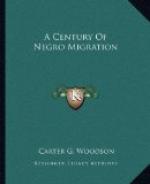The children of the Richards, another old family, were in no sense inferior to the descendants of the others. The most prominent and the most useful to emerge from this group was the daughter, Fannie M. Richards. She was born in Fredericksburg, Virginia, October 1, 1841. Having left that State with her parents when she was quite young, she did not see so much of the antebellum conditions obtaining there. Desiring to have better training than what was then given to persons of color in Detroit, she went to Toronto where she studied English, history, drawing and needlework. In later years she attended the Teachers’ Training School in Detroit. She became a public-school teacher there in 1863 and after fifty years of creditable service in this work she was retired on a pension in 1913.[39]
The Negroes in the North had not only shown their ability to rise in the economic world when properly encouraged but had begun to exhibit power of all kinds. There were Negro inventors, a few lawyers, a number of physicians and dentists, many teachers, a score of intelligent preachers, some scholars of note, and even successful blacks in the finer arts. Some of these, with Frederick Douglass as the most influential, were also doing creditable work in journalism with about thirty newspapers which had developed among the Negroes as weapons of defense.[40]
This progress of the Negroes in the North was much more marked after the middle of the nineteenth century. The migration of Negroes to northern communities was at first checked by the reaction in those places during the thirties and forties. Thus relieved of the large influx which once constituted a menace, those communities gave the Negroes already on hand better economic opportunities. It was fortunate too that prior to the check in the infiltration of the blacks they had come into certain districts in sufficiently large numbers to become a more potential factor.[41] They were strong enough in some cases to make common cause against foes and could by cooperation solve many problems with which the blacks in dispersed condition could not think of grappling.
Their endeavors along these lines proceeded in many cases from well-organized efforts like those culminating in the numerous national conventions which began meeting first in Philadelphia in 1830 and after some years of deliberation in this city extended to others in the North.[42] These bodies aimed not only to promote education, religion and morals, but, taking up the work which the Quakers began, they put forth efforts to secure to the free blacks opportunities to be trained in the mechanic arts to equip themselves for participation in the industries then springing up throughout the North. This movement, however, did not succeed in the proportion to the efforts put forth because of the increasing power of the trades unions.




